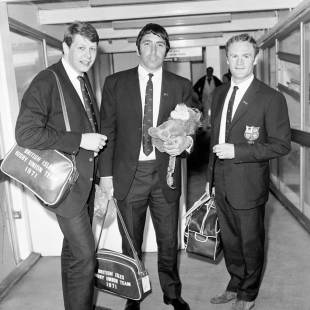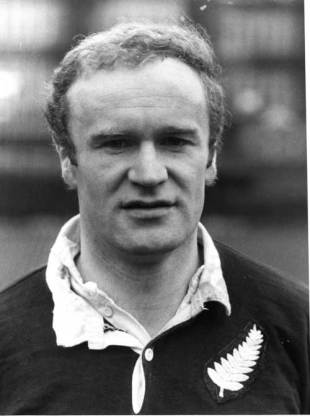|
1964
'The most complete footballer I ever saw'
Huw Richards
January 21, 2014

The great Mike Gibson © PA Photos
Enlarge
It will be 50 years next month since a great debut that, unlike some memorable bows, led on to a still greater international career. Ireland arrived at Twickenham on February 8 1964 without a win at England's home since their Grand Slam-winning year of 1948. They left with the most resounding of their 13 victories there, orchestrated by their debutant outside-half, Mike Gibson. Gibson was 21, a first year law student at Cambridge whose form in the Varsity match had persuaded the Irish selectors to dispense with the experienced and well-regarded Mick English. Their judgment, after what the Playfair Rugby Union Annual recorded as an 'uncertain start' was richly justified. The contrast with England's own debutant pivot, Tom Brophy, was noted by the New Zealand writer Terry McLean: "The large crowd…was put into a ferment of excitement by every one of Brophy's breakthroughs, more than 20 in all…England scored only once from these numerous cuts. Gibson, on the other hand, cut four times and Ireland, which won the match by 18 points to five, scored from three of these cuts." Two in particular were memorable. A clean break near the English line created the opening score for flanker Noel Murphy, then a dummy and break, followed by a reverse-pass to centre Jerry Walsh created the incision which led to a superb score for wing Pat Casey.
A star was born, and few have been more durable or universally admired. Gibson was still playing international rugby 15 years later, making his final appearance for Ireland at Sydney in June 1979. He retired as the world's most-capped player, with a total of 81 tests - 69 for Ireland and 12 for the Lions. His five Lions tours tie with his Ulster and Ireland contemporary Willie John McBride. His 56 Five Nations appearances remained a record until overtaken by Ronan O'Gara, while his number of starting appearances - also 56 - until eclipsed last year by Brian O'Driscoll. Both have of course had the advantage of an extra match each year. Gibson played alongside other great Irishmen, McBride, a colleague in 62 matches, prop Ray McLoughlin and flanker Fergus Slattery. But he did not always play in great teams. Gibson was also the most defeated player of all time, with 39 losses and 11 draws, at the time of his retirement. Ireland won only a single championship in his time, 1974, although they were thwarted by final-match defeats in 1965, 1967 and 1969 and the security worries that led to the cancellation of home matches against Scotland and Wales after they had won in France and England in 1972. There was, though, much to justify TV commentator Bill McLaren's description of him as "the most complete footballer I ever saw". There may never have been a better back division than the 1971 Lions in New Zealand, and Gibson at centre was an integral part, not merely the equal but a vital enhancement of a battery of Welsh brilliance.

Mike Gibson (right) prepares to board the plane for the 1971 Lions tour
© PA Photos
Enlarge
He was, as McBride wrote in his memoirs "a world-class outside-half who became a world-class centre". His first international appearances at centre were for the 1966 Lions, playing all four tests against New Zealand to allow David Watkins to preside at 10. The real switch waited for another three years. He had played all four Lions tests in South Africa at outside-half in 1968 - the first as international rugby's first ever replacement, coming on for the injured Barry John. But when he in turn was injured later in the year Ireland found a more than capable deputy in Barry McGann, and decided that Gibson would fit better at inside centre - the position in which he would play so brilliantly for the Lions in 1971 - on his return. He was quick enough to fit in four caps as a wing right at the end of his career, and always ready to fill in as a goal-kicker on the occasions - which seemed to happen about once every three years - when Ireland was short of one. His career total of 112 points, including nine tries, (although excluding the hat-trick he scored for Ireland/Scotland against England/Wales in 1972) was second only to Tom Kiernan among Irishmen and among the top 20 from anywhere when he retired. But perhaps the greatest tribute to his brilliance was the range of talents discerned by admirers. McLaren noted the creativity of "a forest animal's instinct for what was on". JBG Thomas reckoned him "the greatest support player in the world". Gerald Davies, a team-mate in 1971, contrasted him with the instinctive genius of Gareth Edwards and Barry John, seeing him as playing "rugby of an intellectual kind". He could, wrote Davies "combine deft footwork and the occasional sleight of hand with tremendous physical and mental commitment." McLaren likened his tackling to 'the crack of doom' while Colin Meads, All Black captain in 1971, bracketed him with Mervyn Davies as the player most responsible for the Lions historic series victory: "I would judge that 80% of All Black back movements came unstuck through Gibson's quickness, still and courage". Gibson in 1971 was, Meads reckoned "As near the perfect rugby player as I have seen in any position".

© Getty Images
Enlarge
Given that praise it seems appropriate that Gibson should have been photographed in February 1974, shortly after one of his greatest individual displays - scoring two tries against England at Twickenham, a decade after his debut - wearing an All Black jersey. His contribution to the 1971 Lions was not confined to brilliance on the field. In an age before coaches were offered huge amounts of film analysis, Gibson's pitch-perfect ability to recall every incident in a match was of immense value to coach Carwyn James. He was also, if his much-anthologised humorous article on Irish outside-halves in the 1979 Wales-Ireland match programme is any evidence, a talented writer - making it a matter of some regret that he has never written an autobiography. Amid this cascade of excellence it comes almost as a relief to read,in Ned van Esbeck's history of Irish rugby, that his three-match spell as Ireland's captain in 1971 "was not a success and he was never happy in the role". Even then, he reclaimed the role for two matches five years later. This is almost the only asterisk - essentially a minor one, since similar demurs have not stopped Gareth Edwards being rated the consensus Greatest Player of All Time - on the record. He shares one other quality with his rival for the title of Ireland's greatest playmaker. Seen well into his 70s among former team-mates waiting to march on to the Lansdowne Road pitch to celebrate the 50th anniversary of Ireland's first Grand Slam, the alert, dapper Jack Kyle looked fit enough to still be playing. Gibson has retained a similar air of youthfulness into pensionable age. Agelessness seems a suitable attribute in a Player for the Ages. © ESPN Sports Media Ltd
| |||||||||||||||
Live Sports
Communication error please reload the page.
-
Football
-
Cricket
-
Rugby
-
- Days
- Hrs
- Mins
- Secs
F1 - Abu Dhabi GP
Abu Dhabi Grand Prix December 11-131. Max Verstappen ()
2. Valtteri Bottas (Mercedes)
3. Lewis Hamilton (Mercedes)
4. Alexander Albon ()
5. Lando Norris ()
6. Carlos Sainz Jr ()
-
ESPNOtherLive >>
Snooker - China Open
Tennis - Miami Open

